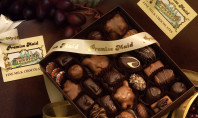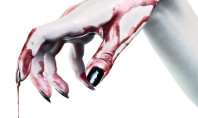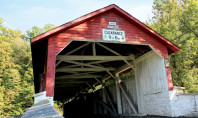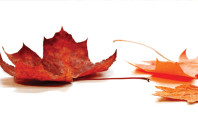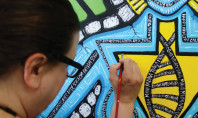The Tale of Count Dracula
By Kathryn Finegan Clark
Want to hazard a guess how many people clad in Dracula costumes will walk, stalk, creep or crawl the streets of the Lehigh Valley on Halloween? The mask, with pale, piercing eyes, blood-red lips and fiercely pointed incisors has long been a favorite of those for whom Halloween means horror – not to mention the handsome formal garb and that sweeping cloak with the face-hiding collar.
Count Dracula, despite the stake driven through his heart, still walks the earth in myriad costumes and often is accompanied by other undead creatures.
But how many wannabe Counts have read Bram Stoker’s novel, “Dracula,” published in 1897, or how many really know anything about the legendary vampires and their origins? Or the real vampire bats, for that matter. Not many – at least not before a resurgence of interest in the macabre tale in the 1970s, according to a Kutztown University professor, who is an expert on vampires and even has a website alive with swooping bats and spooky music.
Dr. Curt Herr’s office at Kutztown differs from most professorial habitats. It’s populated with statues of vampires, most of them gifts from friends, with a few skulls from the Mexican Day of the Dead thrown in for extra spookiness. His students love it. Herr, who holds a doctorate from Fordham University, is a Gothic and Victorian pop culture scholar and a Vampire historian. Among the classes he teaches are Gothic fiction, early working-class British horror fiction and Victorian sensation fiction.
A scholar and writer, Kerr also has spoken extensively in this country and abroad about Gothic literature. He and his Kutztown English Department colleague, Dr. Anne DeLong, are co-editors of “The Journal of Dracula Studies,” which features works about Stoker, Dracula and vampires by scholars from around the world. Herr’s doctoral dissertation at Fordham, “Born from the Stinking Streets: The Rise of Victorian Penny Fiction,” was picked up by Zittaw Press and printed as an introduction to a modern edition of James Malcolm Rymer’s “Varney the Vampire,” or “The Feast of Blood,” a popular “penny dreadful” novel, published a half century before Stoker’s Count Dracula appeared.
The penny dreadfuls of the early 19th Century were cheap paperbacks that sold in installments for a penny each. They were populated with dark villains, pale heroines, stormy skies, piercing screams, ghosts, demons and turreted castles with hovering bats.
Like their literary counterparts they sleep during the day and only emerge in darkest hours of night.
Herr has been publishing critical editions of best-selling Victorian popular fiction ever since his initial work on Varney. “These novels are what the Victorians actually were reading, not necessarily what they should have been reading,” he said. The novels, originally written for the working class who had just become literate, made a strong statement about good versus evil and dealt with the fears and anxieties of Victorian society, emotions and tensions, Herr said, “are still relevant today.”
The fact that his students fell in love with the books surprised him. He said he thinks that’s because the novels “take us out of the continuous stress of modern life and away from technology.”
Legendary demons and monsters who require human blood have terrified most civilizations since the beginning of time, but the vampire legend really took root in the 18th century in Eastern Europe with many vampire sightings and stakings reported.
The vampires most people recognize are revenants, human corpses, or The Undead, supposedly leaving the grave to harm the living. People often attributed bad luck, sickness or disaster to someone who had died and they often dug up their graves to make sure they were really dead. This, of course, led to some grisly discoveries that only fed the superstitions.
Mass hysteria and graveyard confrontations loomed large and the over-sized fears eventually spread throughout the continent. Ironically, this period was considered the Age of Enlightenment, but scientific knowledge was still limited. Superstition was rife at this time and misconceptions about death and normal decomposition of the body caused panic among the populace. The legend of the Undead was a dramatic one and it lives on in popular fiction.
The literary vampire has gone through several stages, starting with Varney as a relatively sympathetic character, caught between good and evil. It evolved to the deadly Count Dracula, who had few, if any redeeming qualities, and possessed an unremitting need to drink human blood. He cast no image in a mirror and had no shadow. In his own terror department, he shrank from sunlight, was frightened of water and repelled by garlic.
The vampire myth hit the silver screen big time in 1931 with Bela Lugosi’s portrayal of Dracula, and that’s the way most people have visualized the vampire since. That vision changed some in the past 40 years with the legend morphing to more attractive, sexy vampires, male and female, in newer works by such contemporary writers as Stephen King, Anne Rice and Stephenie Meyer.
Meanwhile, the literary legend has done damage to the reputations of real vampire bats. Yes, they do exist in the tropical areas of Mexico and Central and South America, and, yes, they are the only mammals that feed entirely on blood. Like their literary counterparts they sleep during the day and only emerge in darkest hours of night to feed on sleeping cattle and horses, although there have been tales of some attacking people. They do not kill, though; they take only the blood they need. Their teeth are razor-sharp and a kind of heat sensor on each bat’s nose points the animal to a warm spot where blood flows just under the skin.
So, any Lehigh Valley vampires you run into on Halloween night are most likely humans posing as vampires, especially if they’re carrying trick-or-treat bags. Remember, if they have a wicked laugh, you’re probably safe, but running away from them is not such a bad idea either. And, a little bag of garlic wouldn’t hurt.


